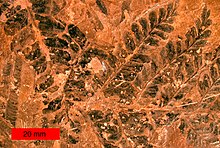
Back سرخسيات بذرية Arabic سرخسيات بذريه ARZ Toxumlu qıjılar Azerbaijani Pteridospermatòfits Catalan Kapraďosemenné Czech Frøbregner Danish Samenfarne German Pteridospermae Spanish دانهسرخستباران Persian Pteridospermatophyta Finnish
| Pteridospermatophyta | |
|---|---|

| |
| Fossil seed fern leaves of Neuropteris (Medullosales) from the Late Carboniferous of northeastern Ohio. | |

| |
| Life restoration of Lepidopteris (Peltaspermales) | |
| Scientific classification | |
| Kingdom: | Plantae |
| Clade: | Tracheophytes |
| Clade: | Spermatophytes |
| Division: | †Pteridospermatophyta |
| Groups included | |
| |
| Excluded | |
| |
| Synonyms | |
|
Pteridospermatopsida | |
Pteridospermatophyta, also called "pteridosperms" or "seed ferns" are a polyphyletic[1] grouping of extinct seed-producing plants. The earliest fossil evidence for plants of this type are the lyginopterids of late Devonian age.[2] They flourished particularly during the Carboniferous and Permian periods. Pteridosperms declined during the Mesozoic Era and had mostly disappeared by the end of the Cretaceous Period, though Komlopteris seem to have survived into Eocene times, based on fossil finds in Tasmania.[3]
With regard to the enduring utility of this division, many palaeobotanists still use the pteridosperm grouping in an informal sense to refer to the seed plants that are not angiosperms, coniferoids (conifers or cordaites), ginkgophytes or cycadophytes (cycads or bennettites). This is particularly useful for extinct seed plant groups whose systematic relationships remain speculative, as they can be classified as pteridosperms with no valid implications being made as to their systematic affinities. Also, from a purely curatorial perspective the term pteridosperms is a useful shorthand for describing the fern-like fronds that were probably produced by seed plants, which are commonly found in many Palaeozoic and Mesozoic fossil floras.
- ^ Elgorriaga, Andrés; Escapa, Ignacio H.; Cúneo, N. Rubén (July 2019). "Relictual Lepidopteris (Peltaspermales) from the Early Jurassic Cañadón Asfalto Formation, Patagonia, Argentina". International Journal of Plant Sciences. 180 (6): 578–596. doi:10.1086/703461. ISSN 1058-5893.
- ^ Rothwell G. W.; Scheckler S. E.; Gillespie W. H. (1989). "Elkinsia gen. nov., a Late Devonian gymnosperm with cupulate ovules". Botanical Gazette. 150 (2): 170–189. doi:10.1086/337763. S2CID 84303226.
- ^ McLoughlin S.; Carpenter R.J.; Jordan G.J.; Hill R.S. (2008). "Seed ferns survived the end-Cretaceous mass extinction in Tasmania". American Journal of Botany. 95 (4): 465–471. doi:10.3732/ajb.95.4.465. PMID 21632371.
© MMXXIII Rich X Search. We shall prevail. All rights reserved. Rich X Search